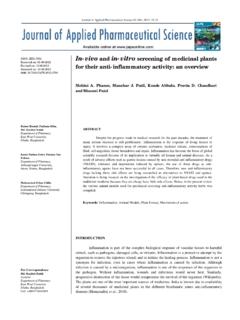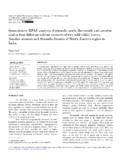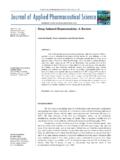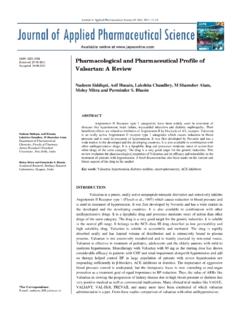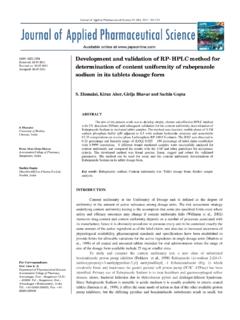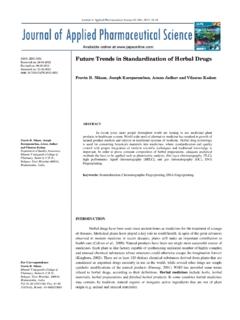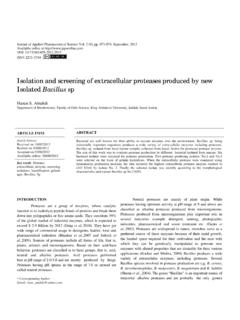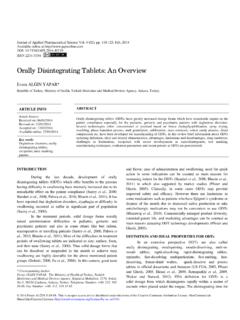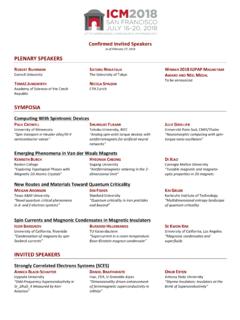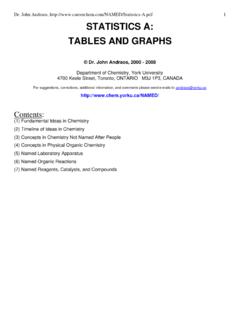Transcription of Nanoparticle: An overview of preparation and …
1 Journal of Applied Pharmaceutical Science 01 (06); 2011: 228-234 ISSN: 2231-3354 Received on: 08-08-2011 Revised on: 10-08-2011 Accepted on: 16-08-2011 Sovan Lal Pal, Utpal Jana, P. K. Manna, G. P. Mohanta, R. Manavalan Department of Pharmacy, Annamalai University, Chidambaram, Tamil Nadu, India. For Correspondence: Sovan Lal Pal Department of Pharmacy, Annamalai University, Chidambaram, Tamil Nadu, India Tel.: + 91-9345239594 Nanoparticle: An overview of preparation and characterization Sovan Lal Pal, Utpal Jana, P. K. Manna, G. P. Mohanta, R. Manavalan ABSTRACT In recent years, there has been an exponential interest in the development of novel drug delivery systems using nanoparticles. Nanoparticles can offer significant advantages over the conventional drug delivery in terms of high stability, high specificity, high drug carrying capacity, ability for controlled release, possibility to use in different route of administration and the capability to deliver both hydrophilic and hydrophobic drug molecules.
2 This review focuses on classification, methods of preparation , characterisation, application, advantages of nanoparticles and health perspectives. Key words: Nanoparticles, preparation , Characterization, Applications. INTRODUCTION The prefix nano has found in last decade an ever-increasing application to different fields of the knowledge. Nanoscience, nanotechnology, nanomaterials or nanochemistry are only a few of the new nano-containing terms that occur frequently in scientific reports, in popular books as well as in newspapers and that have become familiar to a wide public, even of non-experts. The prefix comes from the ancient Greek through the Latin nanus meaning literally dwarf and, by extension, very small. Within the convention of International System of Units (SI) it is used to indicate a reduction factor of 109 times.
3 So, the nanosized world is typically measured in nanometers (1nm corresponding to 10-9 m) and it encompasses systems whose size is above molecular dimensions and below macroscopic ones (generally > 1 nm and < 100 nm). Nanotechnology is the science of the small; the very small. It is the use and manipulation of matter at a tiny scale. At this size, atoms and molecules work differently, and provide a variety of surprising and interesting uses. Nanotechnology and Nanoscience studies have emerged rapidly during the past years in a broad range of product domains. It provides opportunities for the development of materials, including those for medical applications, where conventional techniques may reach their limits. Nanotechnology should not be viewed as a single technique that only affects specific areas. Although often referred to as the tiny science , nanotechnology does not simply mean very small structures and products.
4 Nanoscale features are often incorporated into bulk materials and large surfaces. Nanotechnology represents the design, production and application of materials at atomic, molecular and macromolecular scales, in order to produce new nanosized materials (Hahens et al., 2007). Pharmaceutical nanoparticles are defined as solid, submicron-sized (less than 100 nm in diameter) drug carrier that may or may not be biodegradable. The term nanoparticle is a combined name for both nanosphares and nanocapsules. Nanospheres are matrix system in which drug is uniformly dispersed, while nanocapsules are the system in . Journal of Applied Pharmaceutical Science 01 (06); 2011: 228-234 which the drug is surrounded by a unique polymeric membrane. This systemic review focuses on Classification, method of preparation , Characterization, application, health prospective and Pharmacological aspects of nanoparticles (Couvreur P et al.)
5 , 1995). Classification of nanoparticles There are various approaches for classification of nanomaterials. Nanoparticles are classified based on one, two and three dimensions (Hett, 2004). One dimension nanoparticles One dimensional system, such as thin film or manufactured surfaces, has been used for decades in electronics, chemistry and engineering. Production of thin films (sizes1-100 nm) or monolayer is now common place in the field of solar cells or catalysis. This thin films are using in different technological applications, including information storage systems, chemical and biological sensors, fibre-optic systems, magneto-optic and optical device. Two dimension nanoparticles Carbon nanotubes (CNTs): Carbon nanotubes are hexagonal network of carbon atoms, 1 nm in diameter and 100 nm in length, as a layer of graphite rolled up into cylinder.
6 CNTs are of two types, single-walled carbon nanotubes (SWCNTs) and multi-walled carbon nanotubes (MWCNTs) .The small dimensions of carbon nanotubes, combined with their remarkable physical, mechanical and electrical properties, make them unique materials (Kohler et al., 2004). They display metallic or semi conductive properties, depending on how the carbon leaf is wound on itself. The current density that nanotubes can carry is extremely high and can reach one billion amperes per square meter making it a superconductor. The mechanical strength of carbon nanotubes is sixty times greater than the best steels. Carbon nanotubes have a great capacity for molecular absorption and offering a three dimensional configuration. Moreover they are chemically and chemically very stable.
7 Three dimension nanoparticles Fullerenes (Carbon 60): Fullerenes are spherical cages containing from 28 to more than 100 carbon atoms, contain C60. This is a hollow ball composed of interconnected carbon pentagons and hexagons, resembling a soccer ball. Fullerenes are class of materials displaying unique physical properties. They can be subjected to extreme pressure and regain their original shape when the pressure is released. These molecules do not combine with each other, thus giving them major potential for application as lubricants. They have interesting electrical properties and it has been suggested to use them in the electronic field, ranging from data storage to production of solar cells. Fullerenes are offering potential application in the rich area of nanoelectronics. Since fullerenes are empty structures with dimensions similar to several biological active molecules, they can be filled with different substances and find potential medical application (Tomalia, 2004).
8 Dendrimers: Dendrimers represents a new class of controlled-structure polymers with nanometric dimensions. Dendrimers used in drug delivery and imaging are usually 10 to 100 nm in diameter with multiple functional groups on their surface, rendering them ideal carriers for targeted drug delivery (Wiener et al., 1994). The structure and function of dendrimers has been well studied. Contemporary dendrimers can be highly specialized, encapsulating functional molecules ( , therapeutic or diagnostic agents) inside their core (Li et al., 2007). They are considered to be basic elements for large-scale synthesis of organic and inorganic nanostructures with dimensions of 1 to 100 nm (Tomalia et al., 2004). They are compatible with organic structure such as DNA and can also be fabricated to metallic nanostructure and nanotubes or to possess an encapsulation capacity (Fu et al.)
9 , 2007). Dendrimers have different reactive surface groupings (nanostructure) and compatible with organic structure such as DNA so their prolific use is particularly in the medical and biomedical pharmaceutical applications of dendrimers include nonsteroidal anti-inflammatory formulations, antimicrobial and antiviral drugs, anticancer agents, pro-drugs, and screening agents for high-throughput drug discovery(Cheng Y et al., 2008). Dendrimers may be toxic because of their ability to disrupt cell membranes as a result of a positive charge on their surface (Mecke et al., 2004). Quantum Dots (QDs): Quantum dots are small devices that contain a tiny droplet of free are colloidal semiconductor nanocrystals ranging from 2 to 10 nm in diameter. QDs can be synthesized from various types of semiconductor materials via colloidal synthesis or electrochemistry.
10 The most commonly used QDs are cadmium selenide (CdSe), cadmium telluride (CdTe), indium phosphide (InP), and indium arsenide (InAs). Quantum dots can have anything from a single electron to a collection of several thousands. The size, shape and number of electrons can be precisely controlled. They have been developed in a form of semiconductors, insulators, metals, magnetic materials or metallic oxides. It can be used for optical and optoelectronic devices, quantum computing, and information storage. Colour coded quantum dots are used for fast DNA Testing. Quantum ots (QDs) refer to the quantum confinement of electrons and hole carriers at dimensions smaller than the Bohr radiuos. QD nanocrystals are generally composed of atoms from groups II and VI (that is CdSe, CdS, and CdTe) or II and V (such as In P) at their core.
